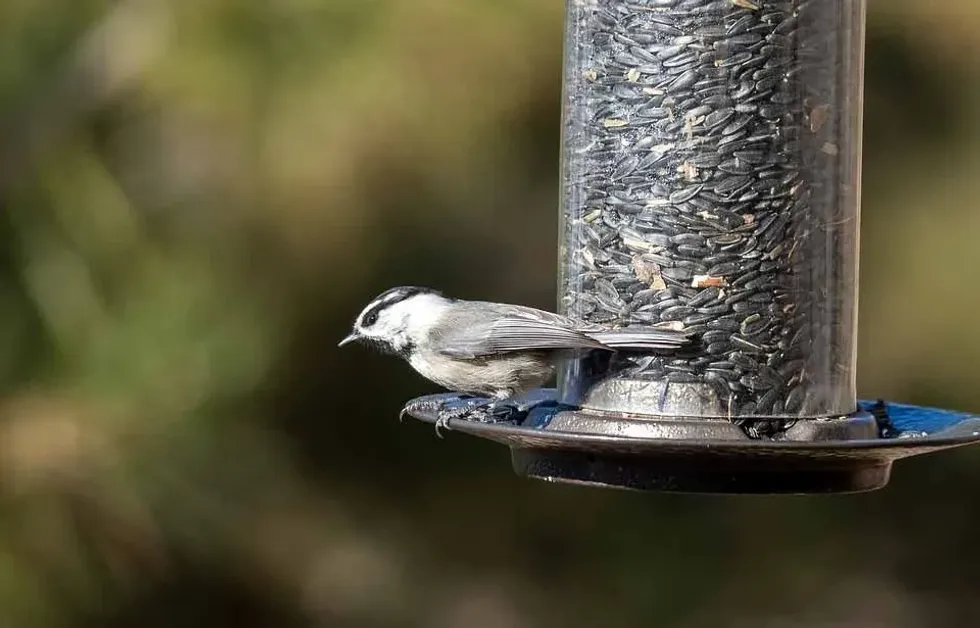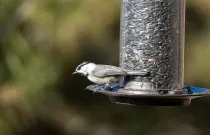Have you been to any mountainous regions lately? If you have, you might have seen a huge variety of birds. Did you see any bird with grey, black, and white eyebrows?
If yes, maybe it was the mountain chickadee (Poecile gambeli). While other birds just sing a song or screech for communication, the mountain chickadee shouts out its name! Yes, it shouts chicka-dee-dee!
Are you curious about the mountain chickadee now? This North American bird is known by its scientific name Poecile gambeli and belongs to the family Paridae and genus Poecile. The mountain chickadee diet comprises seeds, eggs, insects, and other common food products.
These birds prefer to spend their time hanging upside down from small branches. Let your inquisitiveness wait no more, and read on to know some interesting facts about the mountain chickadee! After reading these interesting mountain chickadee facts, do check our other articles on quails and magpies.
Mountain Chickadee Interesting Facts
What type of animal is a mountain chickadee?
The mountain chickadee, Poecile gambeli, is a type of bird, which lives predominantly in mountainous regions, and is found mainly in the United States. It is not usually a migratory bird and prefers to stay in the same region year-round.
What class of animal does a mountain chickadee belong to?
The mountain chickadee is a bird and belongs to the Aves class of animals.
How many mountain chickadees are there in the world?
There are roughly 7.5 million mountain chickadees in the world as of now, but the number has been on a decline for many years, and the number has nearly halved when compared to the population of mountain chickadees in 1996.
Where does a mountain chickadee live?
Mountain chickadees have their population spread across the United States, North America, and Canada. 80 % of their population resides in the United States in North America, whereas 19 % of mountain chickadees’ population resides in Canada.
Mexico has around 1 % population of mountain chickadees.
Though this bird species prefers to live in high-elevation areas such as Pinyon-Juniper woodlands, instead of lower elevations, food shortages may prompt them to move to lower elevations during the winters. Usually, this species can be seen hanging upside down from branches, eating food from twigs.
What is a mountain chickadee's habitat?
Mountain chickadees prefer to live in mountainous dry coniferous forest regions in North America. However, in winter, when the temperature goes fairly low and survival becomes difficult, these North American birds usually fly down to areas with lower altitudes for a short period.
This is not the case for every winter, and hence, these species are not termed migratory birds, as this bird prefers to stay in the same region all year round.
Who do mountain chickadees live with?
In summers, mountain chickadees, order Passeriformes family, live in family groups on treetops in a mountain chickadee bird house, but during the winters, these North American birds prefer to live as a part of a large flock with a dozen or more birds in it. These species prefer to survive in large groups until the cold winter passes by.
How long does a mountain chickadee live?
A mountain chickadee's life span is up to eight years in the wilderness in North America, and the oldest living mountain chickadee to be recorded lived more than ten years.
How do they reproduce?
The female mountain chickadee lays around five to eight eggs and incubates them for roughly two weeks. During the incubation and breeding season period, the male mountain chickadee must bring food to the nest.
Mountain chickadees seldom make their nests and usually use nests made by other birds. The young black-capped chickadee birds, once hatched, stay with their parents for roughly three weeks before flying off on their own after the breeding season.
What is their conservation status?
The number of mountain chickadees has been declining lately due to the overhunting of these birds in many mountainous regions. However, there are still roughly 7.5 million mountain chickadees in the world, which puts them in the Least Concern conservation status. Hence, no concerted efforts are required for the conservation status of this species.
Mountain Chickadee Fun Facts
What do mountain chickadees look like?

Mountain chickadees are black-capped chickadees, with a black strip near their eyes behind the white eyebrows. These species have pale grey bellies and a short black bill and a black-capped chickadee. Their back and flanks are also gray but slightly darker than their bellies. Mountain chickadee leg bands can also be seen.
How cute are they?
Mountain chickadees can be considered rather cute, owing to their soft body and colors of many shades of grey and black. Their soft bodies make them look very cute.
How do they communicate?
Mountain chickadees use vocalizations through a sweet whistled song. This vocal method of communication enables mountain chickadees to convey their messages to other mountain chickadees.
It has been found that mountain chickadee songs are different for birds residing at different elevations. A bird living at lower altitudes sings the song differently when compared to a mountain chickadee residing at a higher altitude.
How big is a mountain chickadee?
Mountain chickadees have a length of around 5-6 in, which shows that they are roughly five times smaller than common ravens, which are usually seen flying in human-inhabited areas.
How fast can a mountain chickadee fly?
Mountain chickadees are known to fly at a speed of 12-13 mph (19-21 kph). This speed is considered to be normal among birds and does not stand out.
How much does a mountain chickadee weigh?
A mountain chickadee weighs around 0.4 oz (11.3 g), which is rather less when compared to other similar birds and is around three times lower than that of a house sparrow.
What are the male and female names of the species?
There are no specific scientific names for male and female mountain chickadees.
What would you call a baby mountain chickadee?
A mountain chickadee is called a chick.
What do they eat?
A rock mountain chickadee's diet consists of nuts by digging them out of bark with their beaks. They also prey on small insects and spiders whenever possible.
Mountain chickadee predators include hawks, owls, and shrikes. Their nests are also predated by tree-climbing mammals such as weasels, when the male mountain chickadees are not around, in which case, they might lose their eggs.
Are they friendly?
Yes, the Californian mountain chickadee is very friendly, but they have not been noticed in human-inhabited areas much due to their habitats being scarcely populated by humans. Still, once helped with food, mountain chickadees remember the favor and are very friendly around that person.
Would they make a good pet?
Of course, mountain chickadees will make extremely good pets. They are very cute and have pretty low requirements for food. Also, they can remember the faces of human beings very well, which helps them in remembering where to return to, and whom to reach out to.
Did you know...
Mountain chickadees can remember the exact locations of the crevices where they hide their nuts and can find the places with much ease.
Also, in a group of mountain chickadees, when a chickadee senses a predator, it shouts its name (chick-a-dee-dee) and warns all other mountain chickadees in the flock. This helps them stay safe from predators.
There is not much difference between a mountain chickadee and a black-capped chickadee.
How fast do a mountain chickadee's wings beat?
Mountain chickadees can beat their wings about 27 times per second, which is roughly three times less than a hummingbird’s, which is around 80 beats per second.
What can mountain chickadees do in summer?
Mountain chickadees try to find the seed that they hid last autumn in various crevices. They can do this easily as they can remember the precise locations where they have hidden the seeds, even if it happened a few seasons ago.
Here at Kidadl, we have carefully created lots of interesting family-friendly animal facts for everyone to discover! Learn more about some other birds including the king vulture and Fischer's lovebird.
You can even occupy yourself at home by drawing one of our Chickadee coloring pages.










